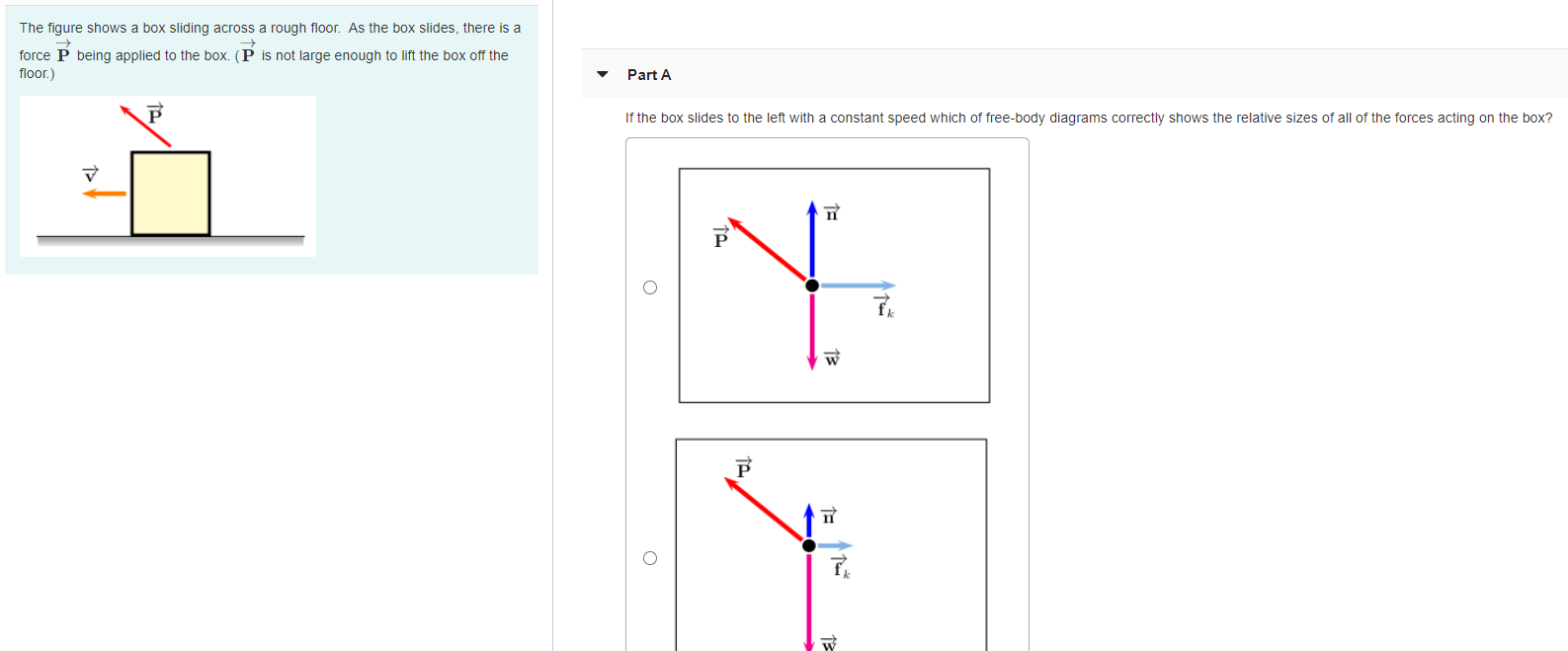Have you ever watched a box slide across a floor and wondered what forces are at play? It seems like a simple act, yet beneath the surface lies a fascinating dance between motion, friction, and the laws of physics. In this article, we’ll delve into the world of sliding boxes, uncovering the scientific principles that govern their movement. From the initial push to the eventual stop, we’ll explore the factors that determine a box’s journey across a horizontal surface.

Image: www.chegg.com
Imagine this: you’re moving into a new apartment, and you need to shift a heavy box across the room. You give it a good push, and the box starts sliding. But, as you watch, it gradually slows down and eventually comes to a halt. What forces are responsible for this motion, and how do they interact to dictate the box’s journey?
The Forces at Play: A Tug-of-War Between Motion and Resistance
The movement of our box is a compelling example of how forces interact in the physical world. Two primary forces govern this scenario: the force applied to the box and the force of friction, which acts as a counterforce. Let’s break them down:
1. The Applied Force:
This is the force you exert on the box when you push it. It’s the initial impetus that sets the box in motion. The strength of this force, measured in Newtons (N), directly influences the box’s acceleration. The larger the force, the faster the box will move initially.
2. The Force of Friction:
As the box slides across the floor, friction rears its head. Friction is a force that opposes motion between two surfaces in contact. The rougher the surfaces, the greater the friction. It’s the reason why a box on a smooth, polished floor slides for a longer distance compared to a rough, carpeted floor.
This force of friction can be divided into two types:
- Static Friction: This is the friction that prevents the box from moving when you first try to push it. It’s a force that keeps the box at rest until the applied force overcomes it.
- Kinetic Friction: Once the box starts moving, the type of friction changes to kinetic friction. This is the frictional force that acts against the box’s motion while it’s sliding. It’s generally less than static friction, which is why the box continues to move once it’s initially set in motion.
Decoding the Journey: Factors Influencing a Box’s Slide
To understand a box’s journey across the floor, we must consider the interplay of these forces and other contributing factors:
- Mass: The heavier the box, the more inertia it possesses, making it harder to accelerate and making friction have a stronger effect.
- Surface Roughness: The rougher the floor, the greater the frictional force. A smooth surface allows for smoother movement and longer slide distances.
- Coefficient of Friction: A crucial factor in determining friction is the coefficient of friction (μ). This value represents the ratio of friction to the normal force (the force pushing the box against the floor). The higher the coefficient, the stronger the friction. Typical coefficients range from 0.15 for a smooth surface to 0.6 for a rough surface.
- Weight of the Box: The heavier the box, the greater its weight, and consequently, the stronger the force pushing it against the floor. Increasing the weight increases friction.
Real-World Applications: Friction’s Impact on Our Everyday Lives
The simple act of a box sliding across a floor has implications that extend beyond our living rooms. Here are some key applications:
- Transportation: Friction plays a critical role in vehicle movement. Brakes rely on friction to slow down cars, while tires utilize friction to grip the road for efficient traction.
- Manufacturing: From conveyor belts to assembly lines, friction influences the smooth operation of industrial processes. It’s essential in preventing parts from slipping and ensuring controlled movement.
- Sports: Friction is an indispensable factor in various sports. The grip of athletes’ shoes on the ground, the friction between a basketball and the court, and the resistance of air on a runner all rely on friction.

Image: www.numerade.com
Minimizing Friction: Seeking Smooth Movement
While friction can be a hindrance in various scenarios, there are methods to minimize its effects:
- Smooth Surfaces: Using smooth materials for surfaces in contact can significantly reduce friction. Polishing surfaces or introducing lubricants like oil can greatly minimize resistance.
- Bearings: Bearings are essential components that reduce friction between moving parts, like in wheels and machinery. They utilize rolling motion to minimize contact between surfaces, effectively minimizing friction.
- Aerodynamics: Optimizing the shape of objects to minimize air resistance, known as aerodynamics, is crucial for reducing friction in high-speed applications like airplanes and race cars.
A Box Slides To The Right Across A Horizontal Floor
A Final Word on the Sliding Box: A Deeper Understanding of Our World
The seemingly simple act of a box sliding across a floor reveals a complex dance of physics that governs our world. From the force applied to the friction that opposes it, each element plays a role in determining the box’s motion. Understanding these principles provides valuable insights into the mechanics of motion, helping us comprehend the forces at play in our everyday lives. So, next time you watch a box slide, remember the scientific forces behind its journey and appreciate the subtle yet powerful interplay that governs our physical world.





